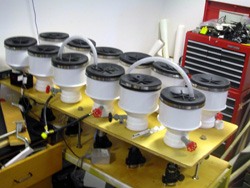Slow Earthquakes in the Pacific Northwest
Measuring micron changes in water height
The float sensors used in University of Colorado long-baseline, water-pipe, tiltmeters
consist of electric light bulbs cemented into gold-plated brass weights fastened at
their base to the core of an LVDT (Linear Variable Differential Transformer) via a
ceramic rod. An identical float sensor is installed at each end of a 500-m-long water
pipe. We have found that these sensors require zero maintenance for periods of many years.

Although the tiltmeters are large they are almost invisible
from the surface.
The float sinks to a point such that the water interface meets the float horizontally (a ≈60° angle of contact of water/glass/air on the upper surface of the reflector bulb). This renders the float insensitive to first-order thermal variations in surface tension.
The float is maintained coaxial with a tube emerging below the base of a 20 cm diameter PVC reservoir, by a flexure strip (in some designs by a weak magnet). The body of the LVDT is fastened directly to the upper surface of a helical pile driven 20-30 m below each end vault. Vertical motions of the water surface are manifest as a varying voltage from the LVDT that are digitized and transmitted to a central recording system via a spread-spectrum radio-modem.
The fundamental vertical resonance of the float is ≈2 Hz . To prevent aliasing caused by oscillations of the float
at the micron level, the data are digitized 10x/sec and are recorded on one-minute averages. The signal
from the two ends are recorded along with pressure and temperature data from each end vault.

Testing 12 tiltmeter sensors, February 2004,
Boulder, Colorado. Each vertical cylinder is
~20 cm in diameter, from the surface.
The reservoir and pipe are fabricated from PVC since their dimensional stability does not dictate the accuracy of the tiltmeter. The measurement is directly between the water surface and the base of the helical pier at each end of the tiltmeter. Temperature effects in the system largely cancel in the difference signal used to extract tilt. Minor differences in temperature between the two vaults (2 m deep and 500 m apart) are treated by determining an empirical correction factor between temperature and vertical displacement at each end.